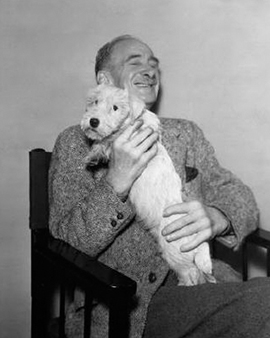As a young man, the British painter Cecil Charles Windsor Aldin published numerous drawings in magazines and newspapers since 1890. He painted rural life in all its facets. Aldin had studied anatomy and animal painting. This had a very positive effect on his illustrations, which immediately captivate the viewer with their loving details. Aldin worked with various painting techniques and used watercolour, charcoal and pastel chalk as well as pencil and ink.
Horse lovers in particular still enjoy Aldin's often humorous depictions of riders, their horses, fully occupied horse-drawn carriages and many a misfortune that can happen when dealing with horses. Anyone who owns one or more dogs will immediately take a liking to Aldin's dog portraits. The painter understood perfectly how to capture everyday motifs from life with his four-legged friend in a very endearing way. Aldin drew from his own experiences. He liked these lovely creatures and also drew dogs that lived with him. Aldin was enthusiastic about the typical British fox hunt, a traditional sport of the upper class, and dedicated numerous pictures to it. In Aldin's time this form of hunting was very popular, but now Britain is critical of fox hunting.
Aldin not only created pictures in which animals are the focus of attention. He made numerous colour lithographs of churches, for example Westminster Abbey and Canterbury Cathedral. He also became known for his illustrations of famous books. Aldin illustrated the first novel by the English writer Charles Dickens "The Posthumous Papers of the Pickwick Club". Aldin will have had even more pleasure in drawing the book for young people "Black Beauty: The Autobiography of a Horse" by the English author Anna Sewell. Over many years he had gained a wealth of experience with animal portraits, especially of horses.
As a dog lover, he will certainly have had a lot of pleasure in illustrating Maurice Maeterling's book "My Dog", a book that describes the inseparable friendship between a bulldog and a man. Aldin also worked as an author, publishing "Old Manor Houses" in 1920 and "Old Inns" a year later, with architectural pictures taken by him. His pictures never seem overloaded, every detail contributes convincingly to the overall impression. Aldin's works paint an authentic picture of British society, full of wit and subtle English humour.
×





.jpg)
.jpg)
.jpg)
.jpg)
.jpg)
.jpg)
.jpg)
.jpg)
.jpg)
.jpg)
.jpg)
.jpg)
.jpg)
.jpg)
.jpg)
.jpg)
.jpg)
.jpg)
.jpg)
.jpg)
.jpg)
.jpg)
_Ec_Ang_-_(MeisterDrucke-947379).jpg)
_Ec_Ang_-_(MeisterDrucke-947379).jpg)
.jpg)
.jpg)
.jpg)
.jpg)
.jpg)
.jpg)
.jpg)
.jpg)
 published by Eyre and Spottiswoode Limited Chalk and Charcoal on paper - (MeisterDrucke-148174).jpg)
 published by Eyre and Spottiswoode Limited Chalk and Charcoal on paper - (MeisterDrucke-148174).jpg)
_-_(MeisterDrucke-1056571).jpg)
_-_(MeisterDrucke-1056571).jpg)
.jpg)
.jpg)
.jpg)
.jpg)
_-_(MeisterDrucke-1114136).jpg)
_-_(MeisterDrucke-1114136).jpg)
 published by Eyre and Spottiswoode Limited Chalk and Charcoal drawing on paper - (MeisterDrucke-183723).jpg)
 published by Eyre and Spottiswoode Limited Chalk and Charcoal drawing on paper - (MeisterDrucke-183723).jpg)
.jpg)
.jpg)
 published by Eyre and Spottiswoode Limited Chalk and Charcoal on paper - (MeisterDrucke-149299).jpg)
 published by Eyre and Spottiswoode Limited Chalk and Charcoal on paper - (MeisterDrucke-149299).jpg)
.jpg)
.jpg)
.jpg)
.jpg)
.jpg)
.jpg)
.jpg)
.jpg)
 1925 - (MeisterDrucke-64699).jpg)
 1925 - (MeisterDrucke-64699).jpg)
 - (MeisterDrucke-50964).jpg)
 - (MeisterDrucke-50964).jpg)
.jpg)
.jpg)
.jpg)
.jpg)
_-_(MeisterDrucke-593925).jpg)
_-_(MeisterDrucke-593925).jpg)
.jpg)
.jpg)
.jpg)
.jpg)
.jpg)
.jpg)
.jpg)
.jpg)
.jpg)
.jpg)
.jpg)
.jpg)
.jpg)
.jpg)
_19th_century_Privat_-_(MeisterDrucke-999127).jpg)
_19th_century_Privat_-_(MeisterDrucke-999127).jpg)
.jpg)
.jpg)
.jpg)
.jpg)
.jpg)
.jpg)
.jpg)
.jpg)
.jpg)
.jpg)
.jpg)
.jpg)
.jpg)
.jpg)
.jpg)
.jpg)
.jpg)
.jpg)
.jpg)
.jpg)
.jpg)
.jpg)
.jpg)
.jpg)
.jpg)
.jpg)
 published by Eyre and Spottiswoode Limited Chalk and Charcoal on paper - (MeisterDrucke-197398).jpg)
 published by Eyre and Spottiswoode Limited Chalk and Charcoal on paper - (MeisterDrucke-197398).jpg)
.jpg)
.jpg)
.jpg)
.jpg)
.jpg)
.jpg)
.jpg)
.jpg)
_england_Coll_Part_-_(MeisterDrucke-1054020).jpg)
_england_Coll_Part_-_(MeisterDrucke-1054020).jpg)
.jpg)
.jpg)
.jpg)
.jpg)
_(for_detail_see_85437_)_-_(MeisterDrucke-558736).jpg)
_(for_detail_see_85437_)_-_(MeisterDrucke-558736).jpg)
.jpg)
.jpg)
.jpg)
.jpg)
_19th_century_Private_Collection_-_(MeisterDrucke-987920).jpg)
_19th_century_Private_Collection_-_(MeisterDrucke-987920).jpg)
.jpg)
.jpg)
_-_(MeisterDrucke-1094413).jpg)
_-_(MeisterDrucke-1094413).jpg)
.jpg)
.jpg)
.jpg)
.jpg)
.jpg)
.jpg)
_19th_century_Private_Collection_-_(MeisterDrucke-947017).jpg)
_19th_century_Private_Collection_-_(MeisterDrucke-947017).jpg)
.jpg)
.jpg)
.jpg)
.jpg)
.jpg)
.jpg)
.jpg)
.jpg)
.jpg)
.jpg)
.jpg)
.jpg)
.jpg)
.jpg)
.jpg)
.jpg)
.jpg)
.jpg)
.jpg)
.jpg)
.jpg)
.jpg)
.jpg)
.jpg)
.jpg)
.jpg)
.jpg)
.jpg)
.jpg)
.jpg)
.jpg)
.jpg)
.jpg)
.jpg)
_19th_century_P_-_(MeisterDrucke-996449).jpg)
_19th_century_P_-_(MeisterDrucke-996449).jpg)
_illustration_from_A_Staircase_of_Stories_publ_-_(MeisterDrucke-1067674).jpg)
_illustration_from_A_Staircase_of_Stories_publ_-_(MeisterDrucke-1067674).jpg)
.jpg)
.jpg)
 From A G - (MeisterDrucke-231851).jpg)
 From A G - (MeisterDrucke-231851).jpg)
.jpg)
.jpg)
.jpg)
.jpg)
.jpg)
.jpg)
.jpg)
.jpg)
_-_(MeisterDrucke-1094412).jpg)
_-_(MeisterDrucke-1094412).jpg)
.jpg)
.jpg)
.jpg)
.jpg)






